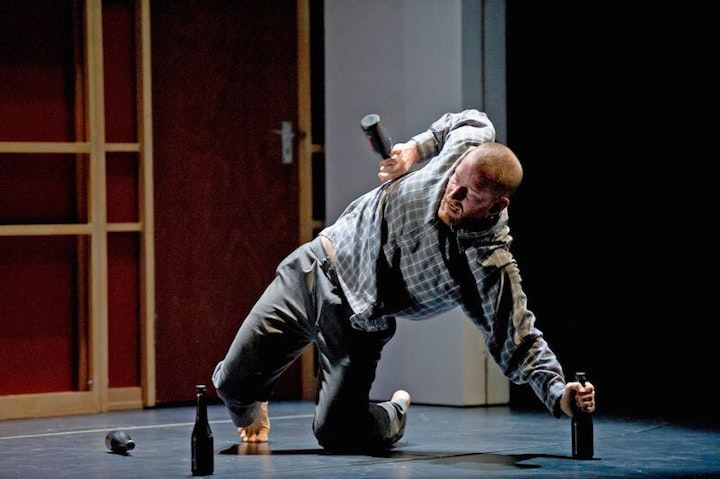As a piece of Verbatim theatre I was drawn to this production because it linked so well to the currently being explored as part of my MA programme. I was particularly intrigued how this, usually text based style of theatre would be transformed into physical dance piece, with a focus on movement rather than narrative, body rather than voice. In fact they blended the two exceptionally well, bringing the very best of both contemporary dance and theatre together.
The set at first sight was very simple made of traditional style theatre flats with no effort to disguise the fact we were seeing the back and therefore the structure of these forms. It was set out as a living room space clearly defined by a sofa and TV. However this seemingly quite rough and simple space quickly came to life as the whole stage began to rotate slowly and steadily. This movement continued throughout the performance always very steady with a speed which demonstrated pace and time passing but never as an audience made us feel sick or unsteady. Often the stage would pause to reveal a longer scene in a single space then begin again on its clockwork journey. The actors used the whole space, moving easily between the rooms, passing through doors as they transformed into different characters, through time and across places. The walls and structure also constantly changed, this was always subtle and seamless. There was never a clunk indicating something had been moved instead just a feeling as an audience of 'oh that looks a bit different now' but actually not always knowing how or exactly when it had changed. The actors always kept our attention and used this set as a playground, sometimes frozen in tableau, or moving fast between walls.
A peppering of props helped to define new spaces, these were sparse, very carefully chosen and with precision placing. For example a lamp in the brace of the flat above a small wooden bench was instantly recognisable as a changing room. Plastic chairs and a bed of foam instantly a hostel, a washing basket and hangers obviously a home. Despite the constant reconfiguration of walls the set was primarily made up of two large rooms with a corridor in between. The action was cleverly defined into these spaces and used accordingly, with the most intimate events often happening in the tight corridor, such as a rape or attack, which made these just fleeting moments for the audience and much left to the imagination.
The narrative was primarily told through a single story told by a single actor, this was the story of 'John' a guy clearly let down by society as he battled through life dealing with major issues including child abuse, drugs, alcohol and sexual identity. There were many other stories and voices that came in and built as the piece developed but having this main character really helped to tie the story together and give a sense of structure to an otherwise very stylistic piece. John's story was tragic but the characterisation of this man and clever editing of content placed dark against light with aspects of humour as well as suffering. The stories from the gay sauna which dominated the later half of the performance were on the whole more lighthearted, they dealt with issues such as safe sex and HIV but in an altogether more upbeat way. In many ways the main story lagged a little at this point but although a bit of a side step for the narrative it proved very enjoyable to experience as an audience, as we saw more diverse characters, movements and stories combined together.
The movements explored within this piece of physical theatre were mesmerising. Utterly contemporary and although sometimes strange they represented the individual characters and events so well. The most compelling aspect was the obvious physical torture of drug abuse which could be seen as legs went wobbly and limbs swayed or twitched. Other physical embodiments of the story and characters included the ticking clock and twitching movements within the office environment and the fast sneaking actions of the shop lifter. There were times when it was hard to tell if the bizarre and exaggerated movements were totally real or supported by some extra tool such as the jumping at the gym or the extreme swaying of drunkenness. The characters worked exceptionally well together exploring contact and interweaving of bodies to show relationships, sex and character links. Repetition was also key to the repertoire of movement, often indicating the passage of time and monotony found within daily life for example the changing room at the sauna featuring constantly dressing and undressing.
Towards the end of the piece we began to occasionally hear the voice of the interviewer. At first this seemed really out of place, this booming voice from above. It was a good way to remind the audience this was Verbatim, real stories, real voices but actually a bit unnecessary and it broke our complete immersion in the turning world in front of us. It reminded the audience of the real origins of the content but really interrupted the fluidity of the piece as a performance. However this reminder of Verbatim was very interesting at the end when we heard John's real interviewed voice and saw the character John perfectly lip syncing and mimicking his real mannerisms. This was highly effective in reminding us he was real and recognising him in the people we have met in real life.
Compelling speeches, convincingly real and edgy characters, innovative set and a real sense of time and pace made this a truly unique and utterly brilliant theatre experience. Contemporary and real, this piece was a fine example of how verbatim can be used to generate powerful, original text and performance.

